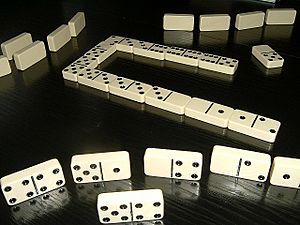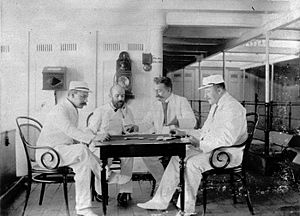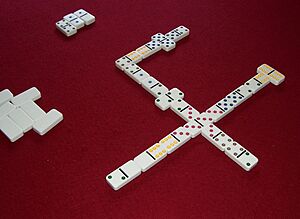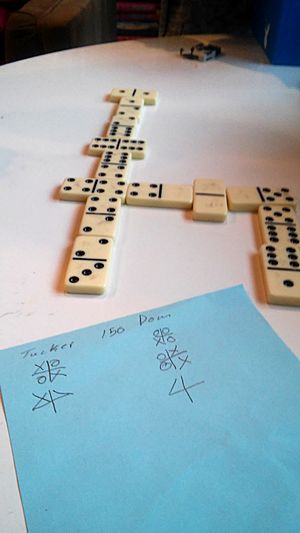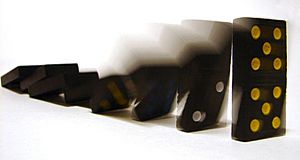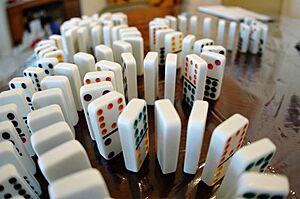Dominoes facts for kids
Dominoes is a fun game played with small tiles. These tiles are also called dominoes. Each domino is a rectangular tile. It has a line in the middle that divides it into two parts. Each part has a number of black spots, called "pips." The number of pips is different on each domino. Some dominoes even have a side that is blank, meaning it has no pips. The games you can play with dominoes are a bit like card games.
Contents
What are Dominoes Made Of?
Long ago, dominoes were often made from special materials like bone or ivory. They also used dark woods like ebony. The pips were usually black or white and were either carved in or painted.
Today, you can find domino sets made from many different things. Some are made from natural materials like stone (such as marble or granite). Others are made from different kinds of wood like ash or oak. You might even find sets made from metal like brass.
Most modern domino sets are made from strong plastics. These plastics can look and feel like old ivory. Some even come in bright colors or are see-through! Modern sets often use different colors for the pips on each end. For example, all the "one" pips might be black, while all the "two" pips are green. This makes it easier to find matching tiles. Sometimes, dominoes have a small metal pin in the middle. This pin is called a "spinner" or "pivot."
Different Sizes of Domino Sets
A common set of dominoes is called a "double-six" set. It has 28 unique tiles. The highest tile in this set has six pips on each end. The pips usually look like the dots on a six-sided dice. But since blank ends (zero pips) are also used, there are seven possible values (0 to 6).
Sometimes, people play with larger sets. These sets have tiles with more pips, like double-nine, double-12, double-15, or even double-18. Larger sets mean more tiles and more combinations. For example, a double-nine set has 55 tiles. A double-18 set would have 190 tiles! These bigger sets are great for playing with more people or for longer games.
The History of Dominoes
The first time dominoes were written about was in China. A writer named Zhou Mi mentioned them in a book from the Yuan Dynasty (1271–1368). He called them pupai. Later, another Chinese writer, Lu Rong, clearly said that pupai were dominoes.
The oldest known book about dominoes is called Manual of the Xuanhe Period. It was written by Qu You.
Chinese domino sets are a bit different from the ones we usually see in the West. Traditional Chinese sets have 32 tiles and no blank faces. They are made to show all the possible results of throwing two dice. They also divide the dominoes into two groups: "military" and "civil." Chinese dominoes are also longer than European ones.
Dominoes came to Europe in the early 1700s, first appearing in Italy. When they came to Europe, the game changed a bit. European sets do not have the "military" or "civil" groups. Instead, they have seven extra dominoes. Six of these have one blank side and one side with pips (from one to six). The seventh extra tile is blank on both sides (0-0).
In the 1800s, people in rural England sometimes used ivory dominoes to settle arguments about land boundaries. They even called them "bonesticks."
Understanding Domino Tiles
Domino tiles are also known as "bones." They are usually twice as long as they are wide. A line in the middle divides them into two square ends. The value of each end is the number of spots or pips on it. In the most common game (double-six), the values go from blank (no pips) up to six pips.
The total number of pips on a tile is called its "rank" or "weight." A tile with more pips is "heavier" than one with fewer pips.
Tiles are often named by their two values. For example, a tile with two pips on one side and five pips on the other is called a "two-five" or "five-two." Tiles that have the same value on both ends are called "doubles." Examples are "double-zero," "double-one," and so on. Tiles with two different values are called "singles."
Each tile belongs to the "suit" of its two values. For example, a 0-3 tile belongs to both the "blank suit" (or 0 suit) and the "3 suit." Doubles are special because they only belong to one suit.
How to Play Dominoes
Most domino games are played in two main ways: blocking games and scoring games.
- Blocking Games: In these games, your goal is to be the first to play all your tiles. You also try to stop your opponents from playing their tiles. At the end, if someone still has tiles, their pips are counted to see who lost.
- Scoring Games: In these games, you earn points during the game for certain moves or for emptying your hand. Scoring is the main goal.
Playing a Blocking Game
A simple blocking game is played by two players using a double-six set. All 28 tiles are mixed up face down. This pile is called the "stock" or "boneyard." Each player picks seven tiles. The rest of the tiles are not used.
Players keep their tiles on edge so they can see their own, but no one else can. This way, everyone knows how many tiles their opponent has left.
One player starts by playing a tile. This tile begins the "line of play." The rule is that the ends of connecting tiles must match. For example, if a tile has a "five" on one end, the next tile played must have a "five" on the end that connects to it.
Players take turns adding one tile to either end of the line of play. If a player cannot play a valid tile, they must keep picking tiles from the stock until they can.
The game ends when one player plays their last tile and wins. The game can also end if no one can make a move. This is called a "block." If the game is blocked, the player who caused the block often wins.
Playing a Scoring Game
In scoring games, players earn points throughout the game. This can happen for making certain matches or for being the first to empty their hand. Many scoring games are like the "draw game." If a player plays their last tile but doesn't say "domino" before it's on the table, and another player says it first, the first player might have to pick up an extra domino.
The Draw Game
In a draw game (which can be blocking or scoring), players can pick more tiles from the stock if they don't have a match. They usually cannot "pass" their turn until the stock is almost empty. The score is often the total pips in the losing player's hand plus the pips in the remaining stock. Usually, two tiles must stay in the stock. The draw game is often just called "dominoes."
Many domino games can be played with more than two players. Players can play by themselves or in teams.
The Line of Play
The "line of play" is how the tiles are arranged on the table. It starts with one tile and usually grows in two directions as players add matching tiles. To save space, players often place tiles at right angles when the line gets too long.
Rules for the line of play can change depending on the game. In some games, "doubles" (tiles with the same number on both ends) can be played in all four directions. This makes the line of play branch out. These doubles are called "spinners." Sometimes, the very first tile played must be a double, and it's the only spinner in the game.
In games like Mexican Train, the game starts with a spinner, and different "trains" branch off from it. Each player usually has their own train, and they can only add tiles to their own train.
Scoring Points
In blocking games, points are counted at the end. When a player empties their hand, their team wins. The score is the total pips on the tiles still held by the losing team. If the game gets blocked, the winner is often the player with the fewest pips in their hand.
In scoring games, each player can earn points. For example, in a game called Bergen, players get two points if both open ends of the line of play have the same value. They get three points if one of those open ends is a double. In Muggins, players score points if the total pips on the open ends add up to a multiple of a certain number.
A popular scoring game in the UK is "5s-and-3s." It's often played in teams of two. The goal is to play a domino so that the sum of the pips on the open ends is a multiple of five or three. You get points for each time five or three can divide into that sum. For example, if the open ends are a 4 and a 5, that's 9. Since 9 is 3 times 3, you get three points. If the open ends are a double-five and a five, that's 15. You get five points (15 divided by 3) and three points (15 divided by 5), for a total of eight points!
A game of "5s-and-3s" ends when a player runs out of dominoes. If no one can empty their hand, the player with the lowest pip count wins one point. Games are played over several "ends" until one team reaches a set score, often 100 points.
Game Play Variations
Many versions of dominoes have been played for a long time. Often, the player with the highest double tile starts the game. For example, "double-six" is played first. If no one has it, the next highest double is called, like "double-five," and so on. If no one has an opening double, the heaviest domino in the highest suit is played, like "six-five."
Sometimes, players take turns picking dominoes from the stock until someone gets an opening double to play. After the first round, the winner of the previous round usually gets to start the next game.
Playing the first tile is sometimes called "setting," "leading," or "downing" the first bone. Domino fans might even say "smacking down the bone." After each round, the tiles are mixed, and players draw new ones, usually seven. Play then continues around the table. Players must play a tile that matches one of the open ends of the tiles already on the table.
In some games, the pips on the end of the tile you play and the section it connects to must add up to a certain number. For example, in a double-six set, the sum might be six. This means you'd play a blank (0) next to a six, a one next to a five, or a two next to a four.
The tiles left in the stock are called the "boneyard," and the tiles in it are "sleeping." In draw games, players pick from the boneyard if they don't have a matching tile in their hand.
If a player accidentally picks up extra dominoes, those tiles become part of their hand. A player who can play a tile might still be allowed to "pass" their turn. You can signal a pass by tapping the table twice or saying "go" or "pass."
The game continues until one player plays all their dominoes and wins the round. They might shout "Out!" or "Domino!" The game can also end if all players are blocked and no one can make a legal move. This is called "locked down." If this happens, the player with the lowest pip count in their hand usually wins. In team play, the team with the lowest individual hand wins.
In games where points are scored, the winning player gets points for each pip on the tiles still held by their opponents. A game is often played until one player or team reaches 100 points. Some games go to 150, 200, or 250 points.
Sometimes, people keep score by drawing "houses." The first 10 points are marked with a large plus sign. The next 10 points are marked with an "O." Scoring five points is marked with a slash (/). These marks are placed in the four corners of the house. One full "house" equals 50 points.
Other Uses for Dominoes
Besides playing games, dominoes are famous for "domino shows." This is when you stand many dominoes on end in long lines. When the first tile is gently pushed, it knocks over the second, which knocks over the third, and so on. This creates a chain reaction where all the tiles fall down! This idea of one small event causing many similar events is called the "domino effect."
People have set up millions of dominoes that take many minutes, even hours, to fall. For very large setups, special "firebreaks" are used. These are gaps or barriers that stop the dominoes from falling too early if there's an accidental bump. They can be removed when the show is ready to begin.
Dominoes can even be used to show how digital signals work. Some people have even thought about building "domino computers"! Dominoes are also often used in Rube Goldberg machines, which are complex machines that perform a simple task in a very complicated way.
The Netherlands has a famous annual event called Domino Day. Since 1986, teams have set up and toppled millions of dominoes. On November 18, 2005, a team knocked over more than 4 million dominoes! On Domino Day 2008, the team tried to set 10 new records, including:
- Longest domino spiral (200 meters)
- Highest domino climb (12 meters)
- Smallest domino tile (7 millimeters)
- Largest domino tile (4.8 meters)
- Longest domino wall (16 meters)
- Largest domino structure (25,000 tiles)
- Fastest topple of 30 meters of domino tiles (4.21 seconds)
- Largest number of domino tiles resting on a single domino (1002 tiles for over an hour)
- Largest rectangular level domino field (1 million tiles)
- A new record of 4,345,027 tiles toppled!
In Berlin, Germany, on November 9, 2009, giant dominoes were toppled. This was to celebrate the 20th anniversary of the fall of the Berlin Wall. The former Polish president, Lech Wałęsa, started the toppling.
Images for kids
See also
 In Spanish: Dominó para niños
In Spanish: Dominó para niños


